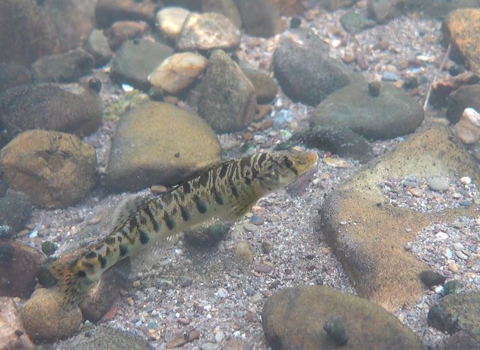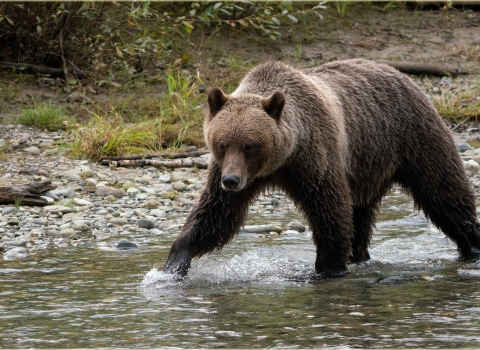Press Release
Secretary Kempthorne Announces Funding for Wetlands Projects, Additions to National Wildlife Refuges
The Migratory Bird Conservation Commission has approved $28.9 million from the North American Wetlands Conservation Fund for 30 conservation projects in 17 U.S. states and 12 Canadian provinces. U.S. partners in 26 projects will add nearly $130 million, including more than $55 million in obligated match, to restore more than 209,000 acres of wetlands and associated uplands. Partners in four Canadian projects will add more than $7.5 million to improve more than 24,000 acres of habitat.
The Commissions action funds grants to diverse public-private partnerships through the North American Wetlands Conservation Act (NAWCA). The grants are financed by Congressional appropriations, fines, penalties and forfeitures under the Migratory Bird Treat Act, interest accrued to the Pittman-Robertson Wildlife Restoration Act and excise taxes paid on small engine fuels through the Dingell-Johnson Sport Fish Restoration Fund.
"This is a marvelous example of how the public and private sectors can and do work together to maintain and expand outdoor opportunities for Americans," said Interior Secretary Dirk Kempthorne. "Acre-by-acre, public and private partners are restoring wetlands across the nation. Wetlands provide excellent habitat for wildlife and provide millions of Americans with a range of outdoor recreational opportunities."
Some 3,150 partners have been involved in nearly 1,800 wetlands conservation projects throughout the United States, Canada, and Mexico since 1990. Partners in all three countries focus on long-term protection, restoration, or enhancement of critical habitats. More than $742 million in grants have been invested in the three countries, and partner contributions have topped $2 billion. Nearly 23 million acres of wetlands and associated uplands across the continent have been positively affected as a result of the program.
The Commission also earmarked more than $6.5 million and approved the acquisition of fee title and conservation easements for 4,253 additional acres of habitat for the National Wildlife Refuge System. New refuge acquisitions, all previously approved by the Service and each of the states, include:
Arkansas: Acquisition of 226 acres to protect waterfowl habitat at White River National Wildlife Refuge in Arkansas, Desha, Monroe, and Phillips Counties and 382 acres at Overflow National Wildlife Refuge in Ashley County.
California: Acquisition of a perpetual conservation easement conservation easement
A conservation easement is a voluntary legal agreement between a landowner and a government agency or qualified conservation organization that restricts the type and amount of development that may take place on a property in the future. Conservation easements aim to protect habitat for birds, fish and other wildlife by limiting residential, industrial or commercial development. Contracts may prohibit alteration of the natural topography, conversion of native grassland to cropland, drainage of wetland and establishment of game farms. Easement land remains in private ownership.
Learn more about conservation easement on 248 acres to protect waterfowl habitat at Grasslands Wildlife Management Area in Merced County and acquisition of a perpetual waterfowl habitat easement on 799 acres at North Central Valley Wildlife Management Area in Sutter County.
Maine: Acquisition of 219 acres to provide nesting and waterfowl habitat at Sunkhaze Meadows National Wildlife Refuge in Penobscot County.
Maryland: Acquisition of 295 acres to provide habitat for waterfowl at Blackwater National Wildlife Refuge in Dorchester County.
Massachusetts/Vermont: Acquisition of 107 acres to provide habitat for waterfowl at Silvio O. Conte National Fish and Wildlife Refuge - Mill River Division - in Hampshire County, Massachusetts, and 76 acres for Nulhegan Basin Division in Essex County, Vermont.
Michigan: Acquisition of 63 acres to protect migratory bird habitat on Detroit River and western Lake Erie shore at Detroit River International Wildlife Refuge in Wayne and Monroe Counties.
Minnesota: Establishment of a new 35,756-acre boundary for future Commission purchase for the new Glacial Ridge National Wildlife Refuge in Polk County and acquisition of 402 acres to conserve prairie pothole wetlands for waterfowl and other migratory bird populations.
New Hampshire: Acquisition of 392 acres to protect waterfowl habitat at Lake Umbagog National Wildlife Refuge in Coos County.
New Jersey: Acquisition of 98 acres to protect waterfowl habitat at Edwin B. Forsythe National Wildlife Refuge in Atlantic, Burlington, and Ocean Counties.
New York: Acquisition of 476 acres to protect waterfowl habitat at Montezuma National Wildlife Refuge in Cayuga, Seneca and Wayne Counties.
Texas: Acquisition of 470 acres to protect waterfowl habitat at Trinity River National Wildlife Refuge in Liberty County.
In addition to money collected from Duck Stamp sales, other funds going to habitat acquisition for refuges are collected from import duties on firearms and ammunition and right-of-way payments to the refuge system. Those funds have provided more than $700 million.
Commission membership includes Secretary Kempthorne, Senators Thad Cochran and Blanche Lincoln, Representatives John Dingell and Curt Weldon, Secretary of Agriculture Mike Johanns, and Environmental Protection Agency Administrator Stephen L. Johnson.
A fact sheet containing summary information about the approved NAWCA projects is available at http://www.fws.gov/birdhabitat/Grants/NAWCA/Standard/files/2006_Sept_StandardGrantSummaryTable.pdf.
The Commissions action funds grants to diverse public-private partnerships through the North American Wetlands Conservation Act (NAWCA). The grants are financed by Congressional appropriations, fines, penalties and forfeitures under the Migratory Bird Treat Act, interest accrued to the Pittman-Robertson Wildlife Restoration Act and excise taxes paid on small engine fuels through the Dingell-Johnson Sport Fish Restoration Fund.
"This is a marvelous example of how the public and private sectors can and do work together to maintain and expand outdoor opportunities for Americans," said Interior Secretary Dirk Kempthorne. "Acre-by-acre, public and private partners are restoring wetlands across the nation. Wetlands provide excellent habitat for wildlife and provide millions of Americans with a range of outdoor recreational opportunities."
Some 3,150 partners have been involved in nearly 1,800 wetlands conservation projects throughout the United States, Canada, and Mexico since 1990. Partners in all three countries focus on long-term protection, restoration, or enhancement of critical habitats. More than $742 million in grants have been invested in the three countries, and partner contributions have topped $2 billion. Nearly 23 million acres of wetlands and associated uplands across the continent have been positively affected as a result of the program.
The Commission also earmarked more than $6.5 million and approved the acquisition of fee title and conservation easements for 4,253 additional acres of habitat for the National Wildlife Refuge System. New refuge acquisitions, all previously approved by the Service and each of the states, include:
Arkansas: Acquisition of 226 acres to protect waterfowl habitat at White River National Wildlife Refuge in Arkansas, Desha, Monroe, and Phillips Counties and 382 acres at Overflow National Wildlife Refuge in Ashley County.
California: Acquisition of a perpetual conservation easement conservation easement
A conservation easement is a voluntary legal agreement between a landowner and a government agency or qualified conservation organization that restricts the type and amount of development that may take place on a property in the future. Conservation easements aim to protect habitat for birds, fish and other wildlife by limiting residential, industrial or commercial development. Contracts may prohibit alteration of the natural topography, conversion of native grassland to cropland, drainage of wetland and establishment of game farms. Easement land remains in private ownership.
Learn more about conservation easement on 248 acres to protect waterfowl habitat at Grasslands Wildlife Management Area in Merced County and acquisition of a perpetual waterfowl habitat easement on 799 acres at North Central Valley Wildlife Management Area in Sutter County.
Maine: Acquisition of 219 acres to provide nesting and waterfowl habitat at Sunkhaze Meadows National Wildlife Refuge in Penobscot County.
Maryland: Acquisition of 295 acres to provide habitat for waterfowl at Blackwater National Wildlife Refuge in Dorchester County.
Massachusetts/Vermont: Acquisition of 107 acres to provide habitat for waterfowl at Silvio O. Conte National Fish and Wildlife Refuge - Mill River Division - in Hampshire County, Massachusetts, and 76 acres for Nulhegan Basin Division in Essex County, Vermont.
Michigan: Acquisition of 63 acres to protect migratory bird habitat on Detroit River and western Lake Erie shore at Detroit River International Wildlife Refuge in Wayne and Monroe Counties.
Minnesota: Establishment of a new 35,756-acre boundary for future Commission purchase for the new Glacial Ridge National Wildlife Refuge in Polk County and acquisition of 402 acres to conserve prairie pothole wetlands for waterfowl and other migratory bird populations.
New Hampshire: Acquisition of 392 acres to protect waterfowl habitat at Lake Umbagog National Wildlife Refuge in Coos County.
New Jersey: Acquisition of 98 acres to protect waterfowl habitat at Edwin B. Forsythe National Wildlife Refuge in Atlantic, Burlington, and Ocean Counties.
New York: Acquisition of 476 acres to protect waterfowl habitat at Montezuma National Wildlife Refuge in Cayuga, Seneca and Wayne Counties.
Texas: Acquisition of 470 acres to protect waterfowl habitat at Trinity River National Wildlife Refuge in Liberty County.
In addition to money collected from Duck Stamp sales, other funds going to habitat acquisition for refuges are collected from import duties on firearms and ammunition and right-of-way payments to the refuge system. Those funds have provided more than $700 million.
Commission membership includes Secretary Kempthorne, Senators Thad Cochran and Blanche Lincoln, Representatives John Dingell and Curt Weldon, Secretary of Agriculture Mike Johanns, and Environmental Protection Agency Administrator Stephen L. Johnson.
A fact sheet containing summary information about the approved NAWCA projects is available at http://www.fws.gov/birdhabitat/Grants/NAWCA/Standard/files/2006_Sept_StandardGrantSummaryTable.pdf.


